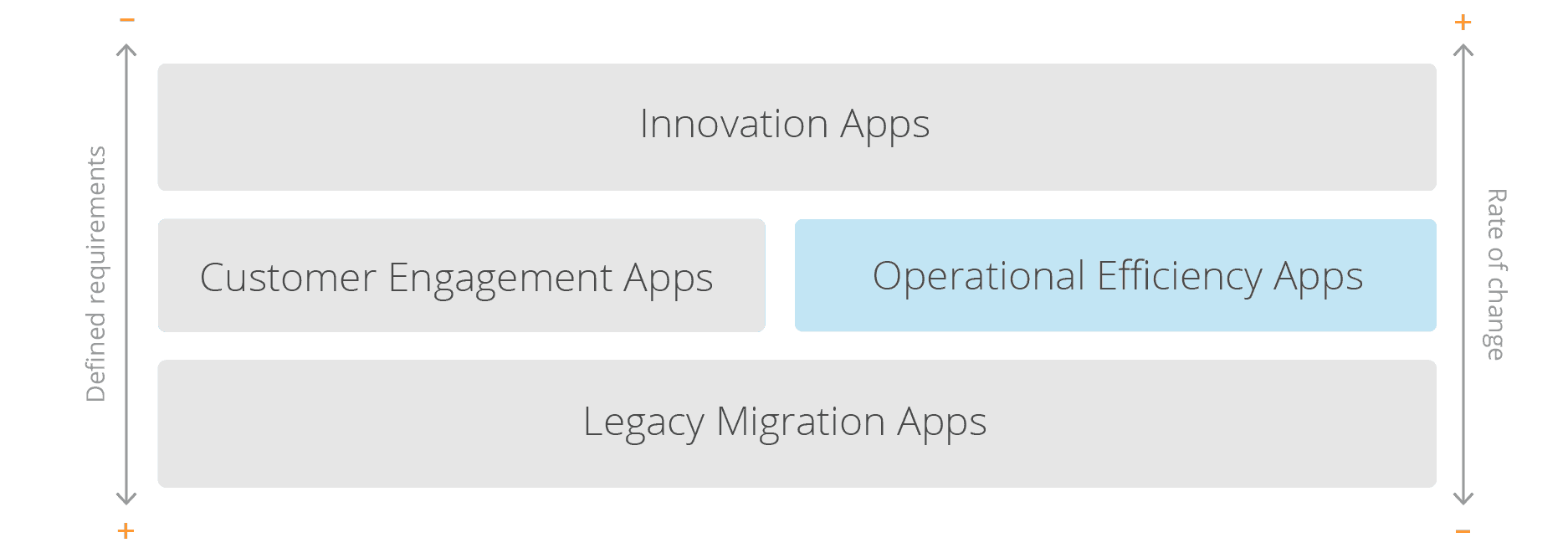In the first blog post of the series, we established four use cases for using a low-code platform (innovation, customer engagement, operational efficiency and legacy migration apps) and mapped them to Gartner’s Pace-Layered Model. The second blog solved the challenges of developing innovation apps and the third blog focused on combating the challenges of developing unique customer engagement apps. In this blog, I will focus on the unique challenges of operational efficiency apps and how a low-code platform helps address them.

Operational efficiency apps are employee-facing (B2E) or partner-facing (B2B apps designed to lower costs by reducing or automating manual, often paper-based processes. These apps may support departmental, cross-departmental or company-wide processes, and are often driven by compliance needs (i.e. avoiding cost penalties), particularly in regulated industries.
Examples of operational efficiency apps include claims processing, supply-chain management, invoice processing, broker workflow automation, device tracking, university registration and order management apps.
These apps require deep domain knowledge and user focus to articulate the right feature-set and user experience. Moreover, because they’re supporting key business processes, they almost always integrate with core systems, and may also replace legacy systems that address parts of the process. The closer the app is to the core of the business; the more critical operational robustness becomes. If the app will be used by the whole company, it becomes mission critical and has to deliver high scalability and performance. This can be challenging for many organizations. Enter the low-code platform!
3 Challenges to Developing Operational Efficiency Apps and the Low-Code Solutions
Misinterpreted requirements
Many operational efficiency projects don’t deliver their intended value because the requirements were misinterpreted and the development team didn’t build the right thing. Low-code platforms harness the knowledge and feedback of the business from the beginning through to delivery and beyond. Visual models provide a shared language that enables business and IT to review, discuss, and validate functionality early and often during the development phase. In addition, look for a platform with an easy-to-use project portal where business users can create and track their own user stories. Also look for built-in agile project management to encourage iterative development while including the business and incorporating their feedback.

Dependencies on core systems
It is often challenging to integrate with Systems of Record due to the complexity of integrating with legacy and off the shelf solutions to implement the required process enhancements and automation. To alleviate these challenges, look for a low-code platform that provides out-of-the-box connectors to common Systems of Record (such as Salesforce, SAP, and Box), enabling less technical developers to orchestrate core systems and automate workflows. In addition, professional developers should be able to create their own connectors and make them available to less technical developers as native platform elements using easy to use and visual integrations.
Managing an ever-increasing app portfolio
There is often a high cost of managing an ever-increasing and evolving app portfolio as organizations address operational efficiency across multiple departments and business units. Look for a low-code platform that applies appropriate governance without compromising time-to-value, including tools to automate testing and monitor quality and performance. Some low-code platforms will provide logging and controls out-of-the-box to ensure compliance and quality across your entire portfolio of apps.
Kao Built Operational Efficiency App on Low-Code Platform that Integrates with SAP
When the owners of elite salons and spas want to offer their clients the best beauty-care products, they turn to Kao, the multi-billion-dollar global leader and maker of such top names as John Frieda, KMS California and Goldwell. But ordering new supplies—for their own use and for retail sale to clients—wasn’t always the smoothest process. Previously, Kao salon sales reps struggled to use a mobile sales laptop application that lacked integrated connectivity or real-time access to back-end data from the company’s SAP system.
Rather than utilizing this laptop app—which disrupted the sales process—the sales team clung to manually taking orders on paper when meeting with the customer. This resulted in sales reps spending unnecessary hours at the end of each day transferring the paper orders into their SAP system.
The sales team needed a simple order-entry system and they needed it right away. Kao was looking at a lengthy and expensive project, and began evaluating app platforms and integration toolsets. They needed a platform that was easy to use, flexible and could quickly integrate with SAP on the back end. This is where Mendix came in.
The speed and flexibility of using a low-code platform were essential to the success of the project. Even with starting the project a few months later than planned, they were still able to deliver the new sales app on time. They had initially estimated 30 days of development time for each interface, but with Mendix, they had working interfaces within two days.
The new order entry iPad app has been rolled out to 400 Kao sales reps globally. The user-friendly app is fully integrated with SAP, giving them real-time access to inventory information and immediate entry of their sales orders. Mendix’s low-code platform and SAP integration capabilities reduced time-to-market by 10 times, allowing Kao to deliver an iPad app that saves sales reps two hours per day.
Key Takeaways
Low-code platforms enable organizations to rapidly deliver operational efficiency applications that can easily integrate into core systems. With a low-code platform, the development of these applications can be an iterative and collaborative process. Business users can easily incorporate their feedback throughout the development process, ensuring the application meets the right set of requirements.
